RSV Virus Directly Infects Neurons and Poses Long-Term Neurological Risks
- Normal Liver Cells Found to Promote Cancer Metastasis to the Liver
- Nearly 80% Complete Remission: Breakthrough in ADC Anti-Tumor Treatment
- Vaccination Against Common Diseases May Prevent Dementia!
- New Alzheimer’s Disease (AD) Diagnosis and Staging Criteria
- Breakthrough in Alzheimer’s Disease: New Nasal Spray Halts Cognitive Decline by Targeting Toxic Protein
- Can the Tap Water at the Paris Olympics be Drunk Directly?
RSV Virus Directly Infects Neurons and Poses Long-Term Neurological Risks
- Should China be held legally responsible for the US’s $18 trillion COVID losses?
- CT Radiation Exposure Linked to Blood Cancer in Children and Adolescents
- FDA has mandated a top-level black box warning for all marketed CAR-T therapies
- Can people with high blood pressure eat peanuts?
- What is the difference between dopamine and dobutamine?
- How long can the patient live after heart stent surgery?
RSV Virus Directly Infects Neurons and Poses Long-Term Neurological Risks
Research Finds Respiratory Syncytial Virus (RSV) Can Infect Neurons and Potentially Cause Inflammatory Nerve Damage.
Respiratory Syncytial Virus (RSV), traditionally believed to only infect the respiratory system, has been shown in a new study to directly invade neurons, triggering excessive inflammation and potentially leading to nerve damage. These findings underscore the potential long-term impacts of RSV and emphasize the importance of preventive measures.
Up to 90% of children contract RSV in the first two years of life, causing highly contagious mild cold-like symptoms. In the elderly, RSV is a significant cause of acute respiratory illnesses, especially in frail or those with other health conditions. Previously thought to affect only the respiratory system, mounting evidence suggests that the virus can spread to non-respiratory tissues, particularly the nervous system, disrupting its function.
While previous studies detected RSV in the cerebrospinal fluid (CSF) of children with seizures or other neurological symptoms, approximately 40% of RSV-positive children under two years old experienced acute brain illness, leading to confusion, memory loss, or cognitive difficulties. Despite clinical data, the cellular mechanisms of RSV’s impact on the nervous system were unclear. A recent study by researchers at the University of New Orleans sheds light on the connection between RSV and neurological symptoms in children.
Lead author Giovanni Piedimonte commented, “This is the most common respiratory virus in the first few years of life and a virus that affects the elderly. This [study] adds new meaning to the importance of RSV vaccines for protecting both the elderly and mothers to safeguard infants.”
Researchers applied a dye to three-dimensional peripheral nerve tissue cultures derived from human stem cells and rat embryos. The dye emits bright red fluorescence during virus replication. Upon observing the virus infecting cells, researchers noted the release of RSV-induced chemokines, critical proteins in the innate immune system that control the migration and positioning of immune cells, causing significant inflammation.
At lower viral loads, RSV primarily infected macrophages, inducing moderate expression of pro-inflammatory chemokines and causing brief peripheral nerve overexcitation. Higher viral loads infected more neurons and macrophages, inducing extensive chemokine expression, loss of macrophages and neurons, and progressive neurotoxicity.

screenshot from Journal of Infectious Diseases
Piedimonte explained, “Before this study, it was believed that inflammation indirectly activated nerves. This study suggests that not only does this occur, but the virus can directly invade nerves.”
Researchers hypothesize that transient nerve overexcitation is more likely chemokine-induced rather than direct neuron infection. Excessive excitation of respiratory system neurons may promote chronic airway hyperreactivity through the recruitment of innate immune effectors via inflammatory chemokines and cytokines, potentially explaining why RSV-infected children are more prone to asthma later in life. Identifying specific chemokines induced by RSV for neuronal hyperreactivity could lead to more precise therapies for bronchitis, asthma, and chronic obstructive pulmonary disease (COPD).
While RSV cannot directly enter spinal cord neurons, the study found it can enter the spinal cord via peripheral nerves. Further research is needed to confirm this mechanism, but researchers believe that by utilizing peripheral nerves, the virus can bypass the blood-brain barrier, enter the central nervous system, and infect the brain. If future studies validate this, it may indicate a connection between RSV and other neurological diseases or developmental disorders.
Piedimonte concluded, “If future research indeed confirms that such viruses can enter the central nervous system, it opens a huge Pandora’s box.”
The study’s results highlight the potential long-term effects of RSV infection and underscore the importance of preventive measures. With the reported increase in RSV infections in the United States, the United Kingdom, and Australia during 2023, especially attributed to the “rebound activity” resulting from the interruption of typical virus activity in the fall and winter seasons due to COVID-19 control measures, these findings are crucial.
In mid-2023, the FDA approved two new RSV preventive tools: nirsevimab (Beyfortus), a long-acting monoclonal antibody for protecting infants and high-risk toddlers; RSVPreF3 (Arexvy) and RSVpreF (Abrysvo), recombinant protein vaccines for adults aged 60 and above, preventing RSV-related lower respiratory tract diseases (LRTD). Later in the year, the FDA approved Abrysvo for pregnant women between 32 and 36 weeks to prevent RSV-related LRTD in infants up to 6 months old. By the end of 2023, the UK regulatory agency also approved Abrysvo for pregnant women and adults aged 60 and above. Australia currently lacks an RSV vaccine.
The research was published in the Journal of Infectious Diseases.
RSV Virus Directly Infects Neurons and Poses Long-Term Neurological Risks
(source:internet, reference only)
Disclaimer of medicaltrend.org
Important Note: The information provided is for informational purposes only and should not be considered as medical advice.



